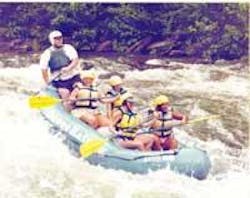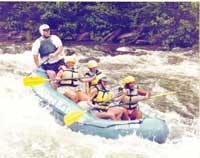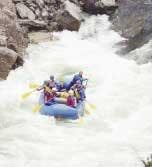Rapids Ahead!
by Janet Hagerman RDH, BS
On Saturday July 20, eight Hygiene Mastery coaches hit the white water at our first annual corporate retreat. Designed as a team-building and experience-expanding weekend, we talked about dentistry for two days and took a break to raft the rapids down the Ocoee River — site of the competition at the 1996 Olympics.
This was my third time down the Ocoee. The river is always different. Although I know what to expect, I still get a thrill and adrenalin rush from running the rapids. The experienced guides do a great job of preparing rafters with appropriate instructions and safety information. If you can follow instructions, you will stay in your raft. The guides are also versed in the ecology of the area and share interesting facts and stories about the river and surrounding terrain. This adds a dimension of local flavor and knowledge to the excitement of the trip.
With my brain full of dentistry and white water rafting (a seemingly unlikely combination), my metaphoric mind started doing somersaults. How is rafting like dentistry? How is the white water experience like the new patient experience? Imagine the metaphor of river riding and how we practice dentistry.
Scenario 1:
Hit And Run Approach
The gorge is huge, very deeply cut and angular. There are no trees along the banks, no branches, ferns, flowers, moss or river boulders. The vertical rock walls, sheered and jagged, cut through the terrain straight down the mountain, revealing the Killer River.
At the top of the gorge several large rafts appear with paying riders and two guides for each boat. At 8 a.m., the flume gates open, releasing torrents of water that rushes down the gorge. The rafters take off. They fly down the gorge. The guides give the rafters no safety advice, other than to hold on tight, because they don't have time. It takes away from "river time." (If they delete instruction time, the guides can actually squeeze in one more trip each day!) They hit the river running. The guides give no interesting insights about the history or etiology of the gorge because they can't be heard for the rushing water, and they are too busy keeping the raft afloat in the violent gush of surging water.
The guides paddle like crazy and shout paddle commands to the rafters. The rafters paddle like crazy and hang on for dear life. They have had no prior communication from their guides, nor been given expectations for the trip.
One of the rafters accidentally gets hit in the mouth by a teammate's paddle handle. This is a common rafting accident, preventable, but no one warned the rafters, or showed them how to prevent it.
Sometimes the rafters fall out. They're scared to death because they haven't been prepared for falls or how to react to them. Sometimes they get rescued and pulled back into the boat ... and sometimes they don't. Occasionally, an unfortunate rafter gets lost or otherwise misplaced, badly dunked, submerged, water tossed, twisted, and/or half-drowned.
Somehow, the guides always manage to get their rafts to the bottom of the gorge, exhausted. Sometimes, they are downright surprised that they make it. The rafters, too, are exhausted. They can't believe they made it either. It was a whirlwind ride and they were scared to death. They think that it was exciting. Just the same, they would prefer to forget about this trip and never return. The company loses a few rafters each year, but what the heck, that just adds to the excitement and challenge of their river ride, reinforcing the name of Killer River.
Scenario 2:
Empower And Enjoy Approach
On the other side of the mountain is another river called Serpent Slide. It slithers down the mountainside like a beautiful snake. It can be dangerous but not deadly. Exciting and challenging rapids are interrupted by benign stretches of river that mercifully merely gurgle along, a respite from the adrenalin rush. The lush green river valley walls tumble with verdant trees, vines, and wildflowers. Moss-covered rocks and boulders, wet and glistening in the sunshine, punctuate the water surface, potentially dangerous yet beautiful.
The rafters arrive early. They meet their guides who explain equipment and river safety, what to expect on the ride, and, more importantly, what to do if you fall out. Once on the water, the rafters practice their strokes. Forward paddle. Back paddle. Don't paddle. Do it together, as a team, like one synchronized dance step, to the command of the guiding leader. It's tempting to disregard these boring basics as elementary, but that would be a mistake. Mastering this simple system, under duress, will ensure swift and safe passage through the rapids instead of a dangerous dunk in the river.
Methodically, they encounter the rapids, one by one. They take on the first rapid, Grumpy's, with success. They fly over Broken Nose, plunder through Slice and Dice, surge over Double Trouble, and finally master Hell's Hole. In between some of the rapids, they get a break. The river surge slows enough for everyone to catch a breath and exchange victorious salutations with teammates. Some of the rafters take a refreshing dip in the river. The guide tells local stories about the area and shares information about the geography, geology, history, and etiology of the river and surrounding plants and animals. Then it's time again to hear the next strategy, from the guide, for negotiating the upcoming rapids and avoiding those beautiful but dangerous rocks.
When these rafters reach the end of their ride, they are tired, but exhilarated. It was an unforgettable experience, comprehensive in its complexities. The rafters were full of extremes of emotion from fear and thrill to rest and serenity. They acquired an appreciation for the power, as well as the pristine peace, of nature. Through it all, they were confident in their guide and certain of their ultimate safety. They celebrate their success, clinking bottles of refreshing mountain spring water. They hug their guide. They talk about "the next time."
Can you see the similarity between river rafting and dentistry? Does your office fly down the gorge by the seat of its pants? Or, does it handle challenges with preparation, guidance, and teamwork? Do you enjoy the ride, the camaraderie and support of your team? Do you take the time to enjoy your surroundings? Or, like the gorge river riders, are you solely focused on getting to the end of your day as quickly as possible, hoping for no catastrophes to occur and ill-prepared if they do?
Our lives and our dental offices are like rivers. Sometimes we fly, sometimes we float. We have opportunities to select different kinds of rivers which provide us with different rides, experiences, and scenery. We always have a choice about which river to ride and how to negotiate it.
Teams that take the time to create systems, commit to training, and have ongoing meetings always fare better in rough water. They enjoy the ride, their patients, the camaraderie, and the support of their team. Why rush through your day in a frenetic race of survival when you can get organized and enjoy the scenery? Choose your river wisely, plan, prepare, practice, and enjoy the ride!
The river wild ... The office wild
null
Here are ten tips about dentistry I learned from the river:
• Research the trip. Your dental office becomes your second home. Take the time to explore your options.
• Select your style. Some people thrive on chaos. If it's not your style, don't do it. Select an office that reflects your personal work style and personality.
• Be prepared. The Girl Scouts knew this when they made it their national motto. Have regular staff meetings. Huddle each morning.
• Safety first. Is your office safe? Are you prepared for emergencies? Are you OSHA compliant? Is your office ergonomically designed for patient and staff safety and comfort?
• Practice. This is also called training. How often, in dentistry, do we expect a new staff member to absorb and acquire our office protocol by osmosis or magic? Got a new program or system to integrate? Plan ahead and role play new strategies.
• Support your team. This means: cross train, lend a helping hand, don't gossip, anticipate assistance.
• Strategize. Use monitors for all systems, review them regularly and implement course corrections as needed.
• Take a break. Even a brief 2-3 minute "refresher" of deep breathing, stretching, or stillness will do wonders for your energy and attitude.
• Enjoy the scenery. Is your office attractive and enjoyable to look at? Do you and your team all have beautiful smiles? Do you take the time to really look at your patients and acknowledge or admire what is pleasant or attractive about them? Take a fresh look at your office through aesthetic eyes. Place fresh flowers to enjoy. Look for beauty in places and people.
• Celebrate every success. Praise your patients for their improvements, no matter how small. Acknowledge team members for their successes. Look for ways to praise each other. Find fun ways to celebrate regularly. (Read 555 Ways To Reward Your Dental Team by Dr. Joe Blaes and Dr. Nate Booth.)
Janet Hagerman, RDH, BS, rides many metaphoric rivers. She is a speaker, author and coach for Hygiene Mastery. For a complimentary assessment of your hygiene department potential, call 888-347-4785 or email janet@hygienemas tery.com


